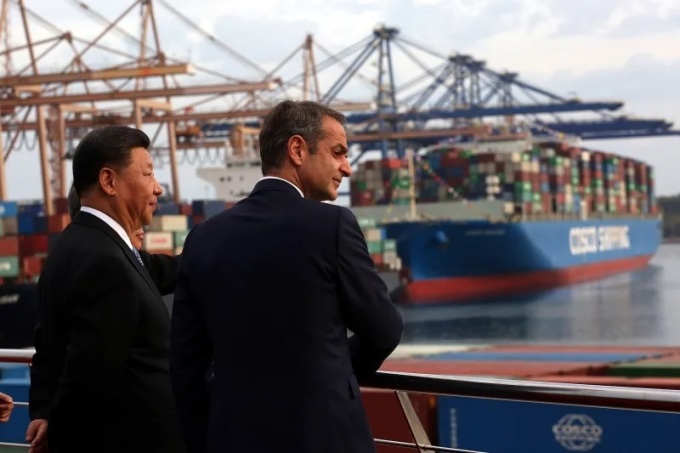Owning and operating nearly 100 ports in more than 50 countries, China's influence and interests are constantly expanding globally.
Over the past few years, US national security officials have become increasingly concerned about China’s growing military might. In its annual US threat assessment in February, Washington described Beijing as a “near-peer competitor.”
China does not have the network of military bases and deployed forces abroad that the United States does. Instead, Beijing quietly expands its influence through a network of nearly 100 commercial ports owned and operated by Chinese companies around the world.
The primary function of this network of ports is to sustain international trade, but that critical infrastructure can also support the global operations of the Chinese People's Liberation Army (PLA), according to Isaac Kardon, a China expert at the Carnegie Endowment for International Peace in Washington, and Wendy Leutert, a professor at the Hamilton Lugar School of International Studies at Indiana University in the US.

Chinese President Xi Jinping (left) and Greek Prime Minister Kyriakos Mitsotakis at the port of Piraeus, Greece in November 2019. Photo: Reuters
Commercial ports are not usually designed for complex military operations, but almost all of them can be used to serve certain missions.
According to research by Kardon and Leutert, PLA Navy warships have been regularly using dozens of overseas ports operated by Chinese companies. At these ports, Chinese military ships often stop to refuel, pick up supplies, and even undergo maintenance and repairs.
Several ports have been used for such purposes, such as Dar es Salaam in Tanzania or Piraeus in Greece. China's network of commercial ports has provided the logistics and support needed to maintain the PLA's ability to conduct missions far from shore.
China’s efforts to expand its global port network are primarily driven by economic considerations. More than 90 percent of China’s trade is carried by sea, far exceeding the global average of 80 percent. Ports around the world play a vital role in China’s imports of energy, minerals, agriculture, and many other goods.
In addition, large container terminals and container ships also help promote the export of Chinese-made goods. The important role of international trade in China's economic development model has gradually made Beijing a leader in the global maritime transport industry.
According to Drewry Maritime Research, as of 2022, Chinese companies owned and operated at least one terminal at 36 of the world’s top 100 ports. By the end of 2022, Chinese companies had acquired ownership or operating stakes in 95 ports in 53 countries across all continents.
But beyond economic goals, China’s efforts to expand its port network are also driven by strategic priorities. Since the late 1990s, China has made establishing a strong position in global markets a central foreign policy goal, offering incentives and support to its companies to expand in the ports and shipping sectors.
In 2013, President Xi Jinping pushed ahead with the Belt and Road Initiative, which aims to connect China to the world through trade, investment and infrastructure. These policies have helped Chinese companies operating in the port sector gradually develop into global leaders.
In its 2015 national military strategy, the Chinese government assigned the PLA the “strategic mission” of protecting the country's trade flows and interests abroad.
Commercial ports have become a key logistics platform for the PLA’s global operations, according to Kardon and Leutert. In addition to serving as a base for refueling, refitting, repairing, or maintaining military vessels, ports can also enhance Beijing’s intelligence-gathering capabilities, as Chinese port operators have exclusive access to ship movements and commercial transactions.
Because ports owned or controlled by China are often located near host country military bases such as in Haifa, Israel, they provide vantage points for observing other countries' military activities and personnel.
The port network is most concentrated along the sea trade routes that connect China to resource import sources such as the Middle East and Africa, as well as major export markets in the Mediterranean. More than half of the overseas ports in which a Chinese company holds a stake are located along the sea routes that run from China through the South China Sea and the Strait of Malacca, across the Indian Ocean, into the Persian Gulf, or through the Red Sea and the Suez Canal into the Mediterranean.
The PLA and analysts call this East-West sea route China's "maritime lifeline," as it connects the country to its largest export market in Europe, as well as to resource imports from the Persian Gulf and Africa.
The Chinese government calls securing the routes along this vital artery a “strategic mission” for the PLA. About 57% of overseas port projects are located near major maritime chokepoints such as the Strait of Hormuz and the Strait of Malacca. Ports operated by Chinese companies span the globe, giving the country’s navy the ability to monitor and interdict the flow of trade and naval power across the world’s major seas.
Other countries such as France and Japan also own and operate large port networks and shipping lines around the world. However, what makes China different is its ability to control and apply security objectives to the operations of domestic and foreign companies.

Chinese research vessel Yuan Wang 5 (right) docks at the deep-water port of Hambantota, southern Sri Lanka in August 2022. Photo: AFP
In 2019, Chinese defense officials said the country had about 40,000 overseas businesses, with foreign investment in the country exceeding $7 trillion. More than a million Chinese citizens work abroad, and about 140 million people travel abroad each year.
As China’s interests expand globally, Beijing must find ways to protect them. And its port network is a powerful tool that can help it do that.
“China’s overseas commercial port network has created a new form of power projection. In the future, the PLA will focus on how ports can support its increasingly far-off operations,” Kardon and Leutert said.
But observers warn that Beijing could face headwinds if it launches complex military operations through commercial ports, saying its power would be constrained by the host country’s government and vulnerable to foreign military forces in the event of war or crisis.
Host governments could suspend port operations, take significant control, or nationalize Chinese facilities if conflict breaks out. As a result, Kardon and Leutert believe the PLA will likely continue to work to establish more specialized bases for military purposes abroad, rather than relying solely on its current network of commercial ports.
Thanh Tam (According to Foreign Affairs )
Source link






































































































Comment (0)